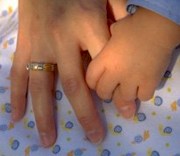Tetralogy of Fallot is made up of 4 heart defects:
- A hole in the wall between the lower chambers (the ventricles), which lets oxygen-poor blood mix with oxygen-rich blood. This is called a ventricular septal defect.
- A narrowed outlet to the pulmonary artery, usually combined with an abnormal pulmonary valve. This can block blood flow from the lower-right chamber (the right ventricle) into the lungs.
- An aorta that straddles the wall (septum) between the lower chambers (the ventricles). This lets oxygen-poor blood flow into the aorta (the main blood supplier to the body).
- Thickened and enlarged heart muscle tissue in the lower-right chamber (the right ventricle).
The narrowed pulmonary valve limits blood flow to the lungs, and the ventricular septal defect allows oxygen-poor blood to be pumped into the body along with oxygen-rich blood. Together, these defects make the level of oxygen in the blood too low. When oxygen-poor blood is pumped into the body, the fingers, toes, and lips may appear blue, a condition called cyanosis.
How is it treated?
Infants with tetralogy of Fallot usually need surgery. Surgery to temporarily improve the condition is called a shunt procedure. This allows more blood to reach the lungs and reduces cyanosis until the defects can be corrected.
Open heart surgery to correct the defects is usually performed between the ages of 8 months and 5 years. The ventricular septal defect is covered with a patch, the pulmonary valve is widened, and a patch may also be placed on the right ventricle to increase blood flow to the lungs. Studies have shown that the earlier surgery is done, the better the heart works later in life.
Return to main topic: Congenital Heart Disease
See on other sites:
MedlinePlus
https://medlineplus.gov/ency/article/001567.htm
Tetralogy of Fallot
American Heart Association
www.heart.org/HEARTORG/Conditions/CongenitalHeartDefects/
AboutCongenitalHeartDefects/Tetralogy-of-Fallot_UCM_307038_Article.jsp
Tetralogy of Fallot
Texas Adult Congenital Heart Center (TACH)
www.bcm.edu/healthcare/care-centers/congenital-heart
This Baylor College of Medicine program enables patients with congenital heart disease to receive a seamless continuation of care from birth to old age.
Updated August 2016



